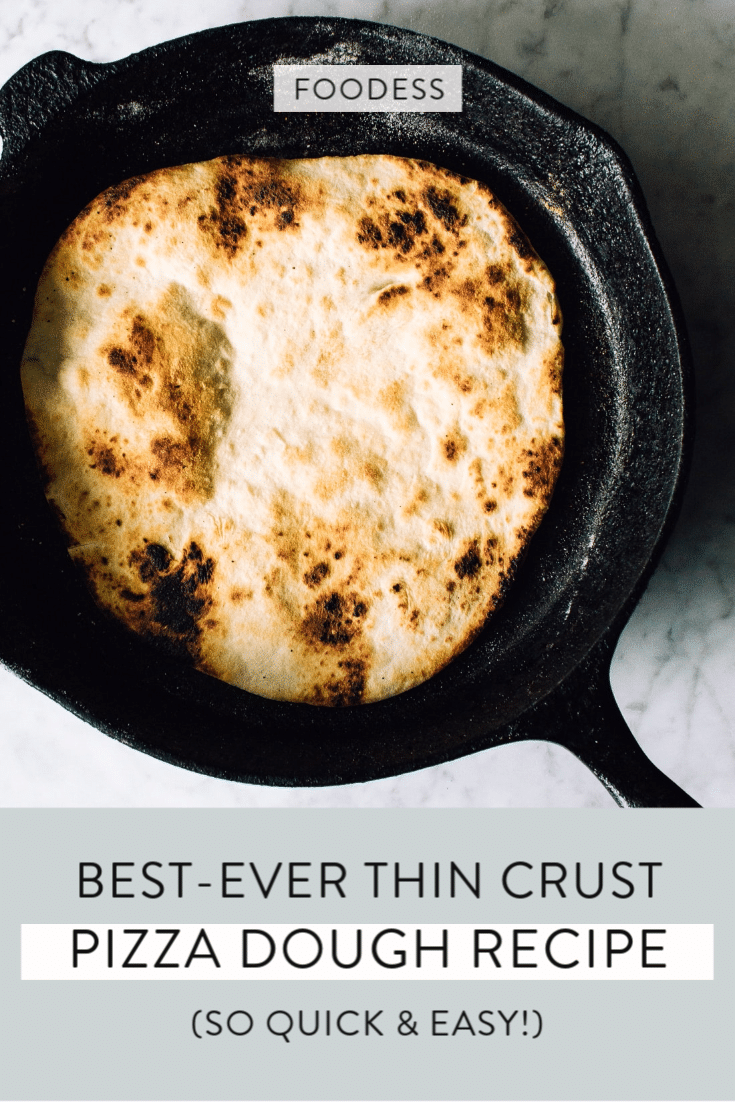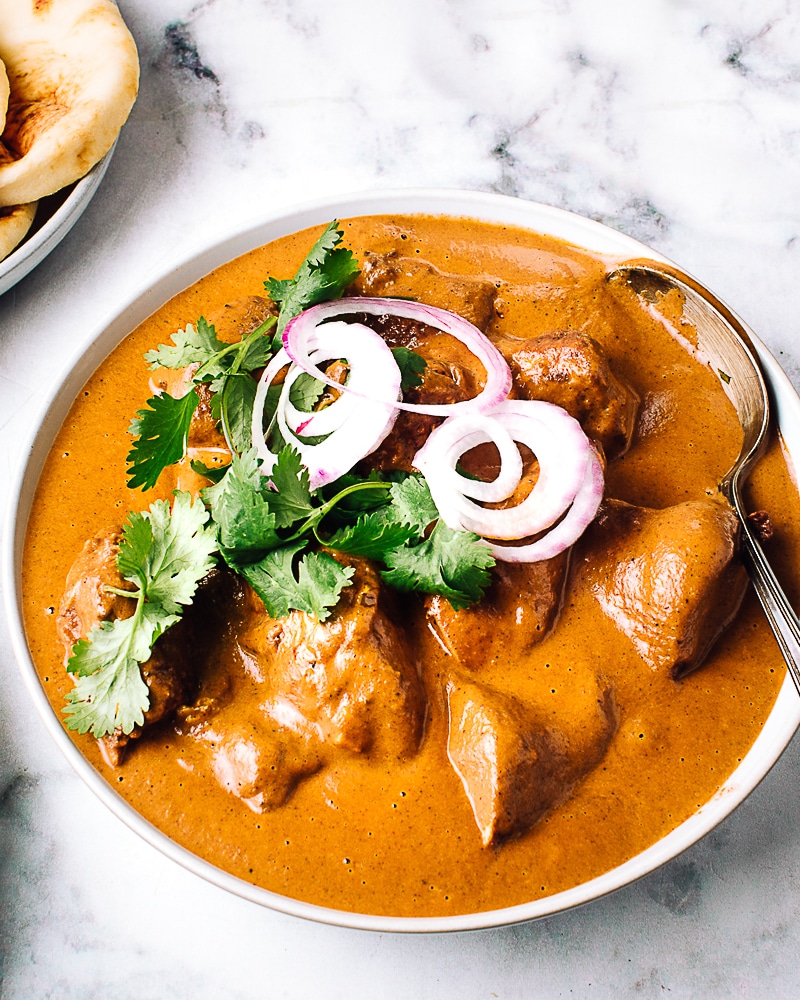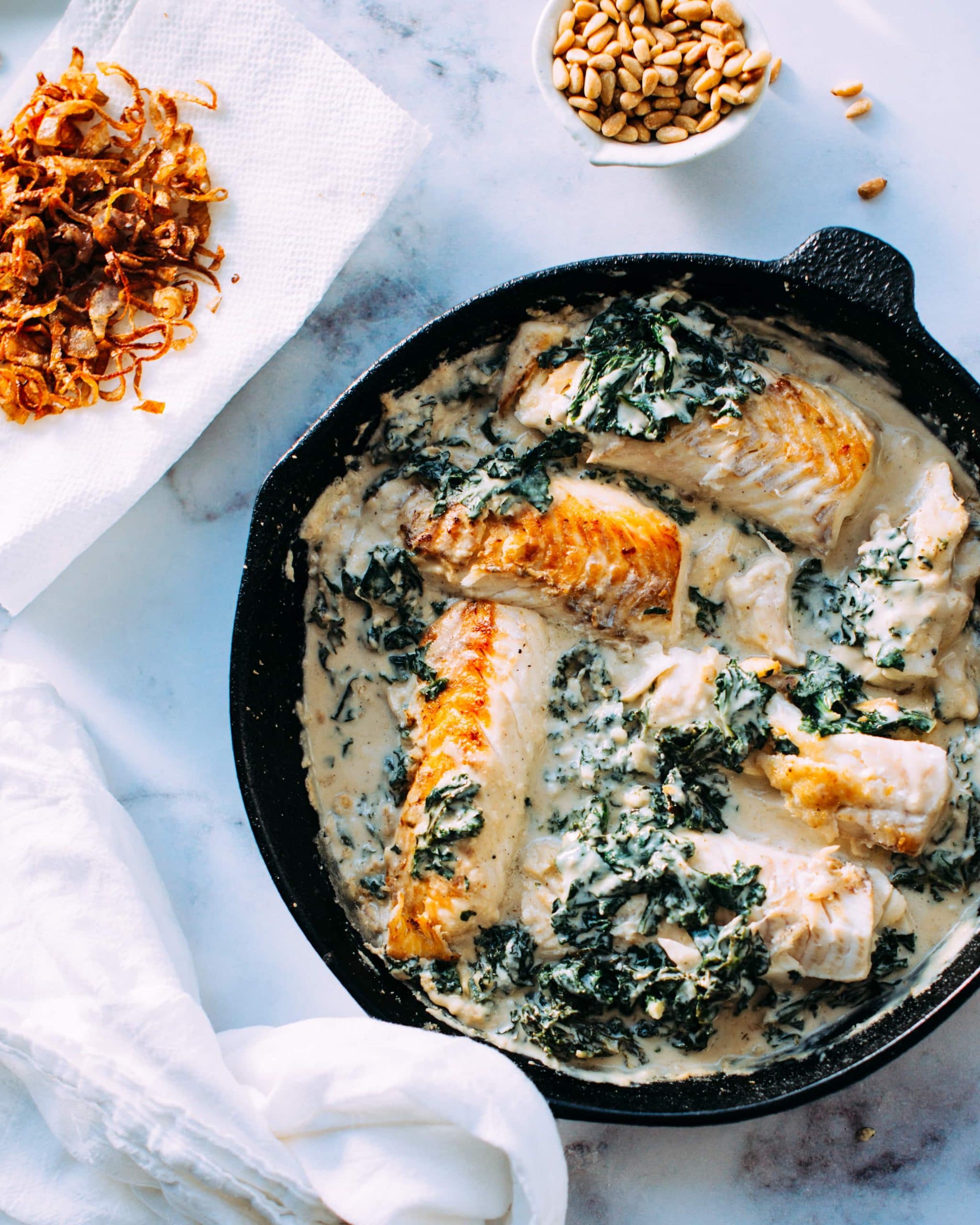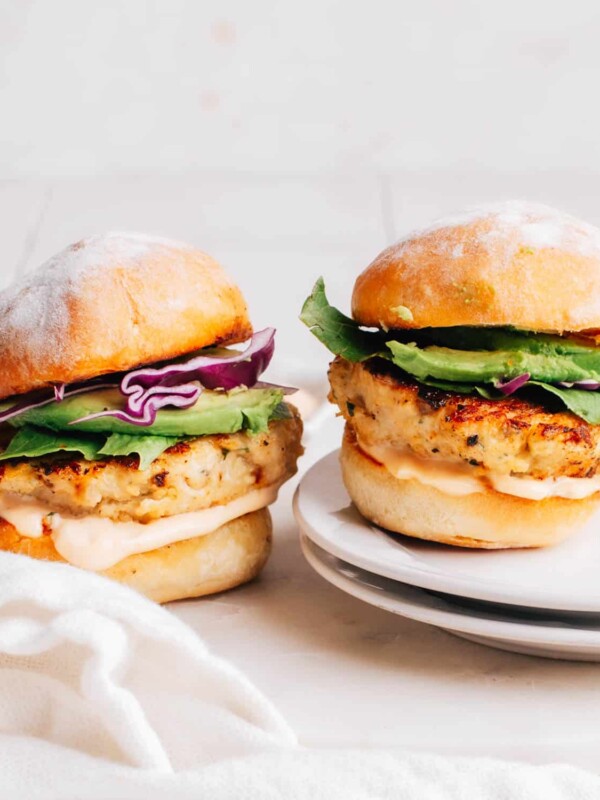If you’re on the quest for the best homemade pizza dough recipe ever (and pizza!), your search is over. I use some savvy tips and tricks to make an quick and easy thin crust pizza that’s as similar to your fav wood-fired oven pizza as you’re gonna get at home.
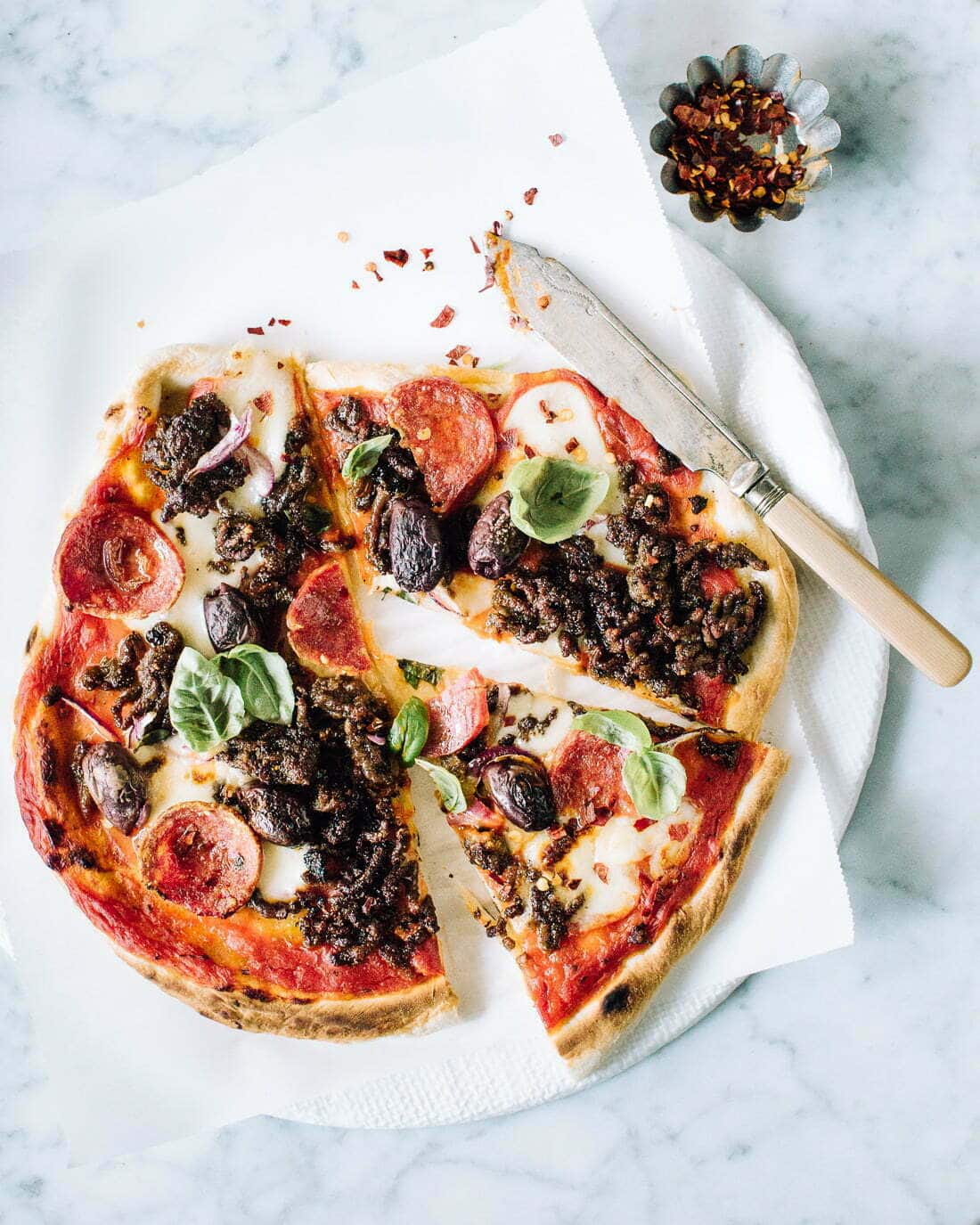
Table of Contents
- Here’s What You Need To Make the Best Pizza Dough Recipe
- How to Make Easy Homemade Pizza Dough Recipe: Easy Step-by-Step Directions
- Notes, Pro Tips and Science-Based Secrets
- How do I make thin crust, crispy pizza like wood-fired?
- Can I substitute instant, rapid-rise, or bread machine yeast for active dry yeast in pizza dough?
- What temperature’s best to bake pizza dough?
- Can you freeze pizza dough?
- FAQ
- The Ultimate Easy Pizza Dough Recipe Recipe
Here’s What You Need To Make the Best Pizza Dough Recipe
Ingredients for Easy Homemade Pizza Dough
Before diving into the pizza-making process, let’s understand the role of each ingredient that will bring this incredible dough to life.
- Warm Water: Acts as the activating agent for the yeast, allowing it to froth and begin the fermentation process.
- Active Dry Yeast: The backbone of any dough recipe, it helps the dough rise, making it airy and soft.
- Granulated Sugar: Feeds the yeast during the fermentation process and adds a subtle sweetness to balance the flavors.
- Extra Virgin Olive Oil: Imparts a luscious richness to the dough and aids in its elasticity. Also used for greasing the bowl to facilitate rising.
- Coarse Salt: Enhances the flavor of the dough and regulates yeast activity during fermentation.
- Bread Flour or All-Purpose Flour: The primary structure of your dough. Bread flour gives a chewy texture, while all-purpose flour makes it softer and more tender.
What’s the best flour for pizza dough?
Bread dough has higher protein content than all purpose. When you knead it with water, the flour’s proteins are what form gluten, the muscle of the dough. A higher-protein flour makes for a sturdier dough, one that can be stretched thinner and one with more chew.
For good measure, I tested the recipe with both bread and all-purpose flours. Both are totally good in the recipe. The all-purpose version was more soft and tender while the bread flour version was chewier. Pizzerias use bread dough. If you have it, use it. If you want pizza tonight and don’t have it, all purpose is just fine.
Variations and Substitutions
Customize your pizza dough to match your own culinary desires with these simple variations and substitutions:
- Gluten-Free: Replace regular flour with a gluten-free flour blend for those with gluten sensitivities.
- Whole Wheat: Swap out white flour for whole wheat for a nuttier, earthier flavor and extra fiber.
- Herbed Dough: Incorporate your choice of dried herbs such as oregano, basil, or rosemary into the dough for added flavor.
- Garlic Infusion: Add minced garlic or garlic powder to the dough mix for a garlic-flavored crust.
- Yeast Alternatives: You you can use instant yeast instead of active dry yeast. Add it directly to the flour and let it rise the same way.
Grab these Tools
Equip your kitchen with these essential tools to make the pizza dough-making process a breeze:
- Stand Mixer: A stand mixer equipped with a dough hook makes kneading effortless, but you can also knead by hand if you prefer.
- Measuring Cups and Spoons: Accurate measurements are key to perfect dough, so make sure you have a set of these.
- Digital Scale: For even greater precision, especially for ingredients like flour, a digital scale can be invaluable.
- Mixing Bowls: You’ll need a large mixing bowl for combining and letting the dough rise.
- Cast Iron Skillet: For that perfect crispy bottom, a cast iron skillet is highly recommended.
- Rolling Pin: To roll out your dough to your preferred thickness, a rolling pin is a must-have.
- Baking Sheet, Pizza Pan or Pizza Stone: Depending on your oven, you may also need a baking sheet or a pizza stone for the actual baking process.
- Spatula or Pizza Peel: To transfer your dough onto your baking surface, a sturdy spatula or a pizza peel will make your life easier.
How to Make Easy Homemade Pizza Dough Recipe: Easy Step-by-Step Directions
Follow these straightforward steps to create your very own delicious pizza dough:
- Yeast activation: Mix warm water, yeast, and sugar to activate the yeast. This step ensures that the dough will rise properly.
- Liquid base: Add olive oil and salt to the yeast mixture to create a flavorful liquid base.
- Initial mixing: Introduce half the flour to the wet ingredients and start mixing. This gradual addition avoids lump formation.
- Additional flour: Continue adding the rest of the flour slowly until a dough ball forms. Aim for a texture that is sticky but doesn’t cling to the sides of the bowl.
- Kneading: Let the stand mixer (or your hands) knead the dough for about 5 minutes. This develops the gluten, making the dough elastic and smooth.
- First rise: Place the kneaded dough in an oiled bowl and let it rise until it has doubled in size. This first rise is crucial for the dough’s texture and flavor development.
- Topping preparation: While the dough is rising, take the time to prepare your pizza toppings. This makes the assembly quicker later on.
- Heat preparation: Preheat your cast-iron skillet and the broiler in your oven. High heat is key for achieving a crispy, wood-fired-like crust.
- Dough division: Once risen, divide the dough into smaller balls and roll each into a circle, ready for toppings.
- Initial cooking: Cook the rolled-out dough in the hot cast-iron skillet until bubbles form and the bottom is brown. This pre-cooking step helps achieve a crispy bottom.
- Topping and final broil: Add your prepared toppings and broil in the oven until the cheese is bubbly and the edges are slightly charred.
- Optional dough freezing: If making in advance or in large batches, freeze individual balls of dough for future use.
Make Ahead and Storage
Maximize your pizza-making experience with these make-ahead and storage tips:
- Dough prep: Prepare the dough up to two days in advance and store it in the fridge. Just let it sit at room temperature for 20 minutes before rolling out, ensuring a pizzeria-quality crust.
- Freezer-friendly: This dough freezes exceptionally well. Make a double batch and freeze individual dough balls for impromptu pizza nights—dinner sorted in a snap! Thaw in the fridge overnight before using, or on the counter for a few hours.
- Leftover revival: Have a leftover slice or two? Reheat in a hot skillet or oven to bring back that just-baked crispiness and oozy, melted cheese.
- Topping storage: Pre-chop and store your favorite toppings in airtight containers in the fridge. This will make pizza assembly quick and effortless next time.
- Sauce ahead: Prepare your pizza sauce in advance and store in an airtight jar. It tastes even better after the flavors meld for a day or two.
Plan wisely, and you’ll find that homemade pizza becomes an even more convenient and tempting meal option!
Notes, Pro Tips and Science-Based Secrets
When I was working in a test kitchen for a flour company, I learned a lot about bread doughs like this one.
Ingredient order: The best way to make a perfect dough every time is to start with your liquids in the bowl, and add the flour in stages until you get a ball of the right texture. It’s easy to add more flour if the dough is sticky. It’s not easy to add more moisture if the dough has become dry. For this pizza dough recipe, you’re aiming for a dough that is smooth and sticky to touch, but not sticking to the sides of the bowl.
Use weight: If you have a scale, absolutely use it. (This is the one I have. It’s only $13 and I’ve had it for years.) There is so much variability in how much four is in a “cup” from person to person, depending on how densely packed it is in the bag. If you don’t have a scale, don’t stress, but do follow best practices for measuring flour. First, fluff it up in the bag or container. Then use a soup spoon and lightly spoon it into the measuring cup until over-filled. Finally, sweep across the top with a knife to level it off.
Sticky is good: This pizza dough is a bit tackier than a typical bread dough because it has a generous glug of olive oil. This means that although it feels sticky to touch, it won’t actually stick much to the counter. Run with it and don’t be tempted to over-flour your dough in the mixer bowl (if you do, it’ll be denser and you won’t be able to roll it as thin). You can always work more in as you’re rolling out.
This pizza dough is a bit tackier than a typical bread dough because it has a generous glug of olive oil. This means that although it feels sticky to touch, it won’t actually stick much to the counter. Run with it and don’t be tempted to over-flour your dough in the mixer bowl (if you do, it’ll be denser and you won’t be able to roll it as thin). You can always work more in as you’re rolling out.
Avoid quick-rising tricks: As tempting as it is to speed up the dough rising with warm environments, resist. A slower rise at room temperature contributes to a deeper flavor profile.
Temperature matters: Using warm water (not hot, not cold) for the yeast helps it activate properly, ensuring a beautiful rise.
Cast-iron + Broiler Magic: Using a cast-iron skillet mimics the high heat of commercial pizza ovens, making your crust crispy and slightly charred. The intense heat from the broiler helps to quickly cook the toppings while crisping up the crust’s edges, mimicking the effects of a wood-fired oven.
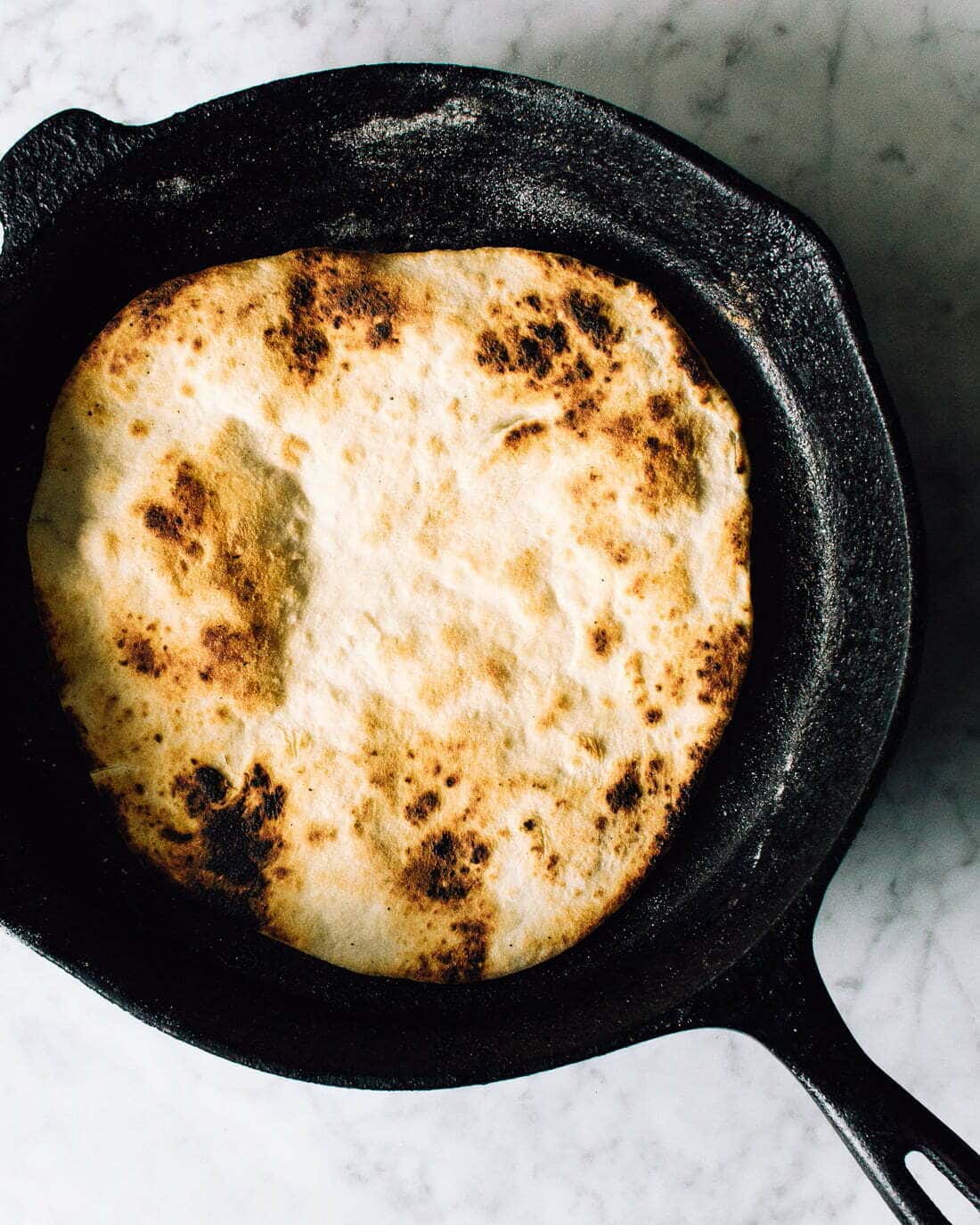
How do I make thin crust, crispy pizza like wood-fired?
It comes down to two things. The pizza dough recipe should make a dough flexible enough to roll very thinly (like the recipe below), and then you need to cook the pizza using very high heat, with particular attention to the bottom crust.
Some people preheat a baking stone in the oven on 500ºF for an hour before baking, but my secret trick is done in just minutes, and yields infinitely better results.
Can I substitute instant, rapid-rise, or bread machine yeast for active dry yeast in pizza dough?
Yes! The first three are actually the same product packaged with different names. Any form of instant yeast doesn’t have to be proofed in water, but it’s perfectly fine to dissolve it in liquid as indicated in the recipe. (Just skip the wait time and move on with the next step.) It’ll likely rise more quickly, too.
Personally, I prefer the more developed flavour of a slower ferment which is why I go with active dry yeast here. A quicker rise can lead to a more pronounced alcohol flavour and strong yeasty smell (rather than the more complex sourdough-y flavours).
For this reason also, I don’t recommend placing your dough in the oven on proof setting, or using any other tricks to make the air warmer than room temperature. You might be tempted to keep the dough warm to hasten the rising process, but you’re doing it at the expense of flavour.
What temperature’s best to bake pizza dough?
This question is the sweet spot. The gold. This is where my tricks come in.
I wanted to emulate the crispy crust and slightly charred flavour of a wood-fired pizza, and baby, I’ve got this figured out.
We start by slapping the dough in a screaming hot cast iron skillet until bubbles form on the surface and the underside is browned and charred in spots. This crisps the bottom of the crust.
Next, we add the toppings. Then we use the broiler to finish cooking the pizzas, again, mimicking the fiery temps of your favourite pizza joint.
I use the convection setting on my oven while broiling. This ensures the dough is cooked through. If you don’t have the broil-plus-convection setting, you’ll want to flip the pizza dough in the cast iron pan for a hot second to make sure the crust isn’t doughy in the middle when served.
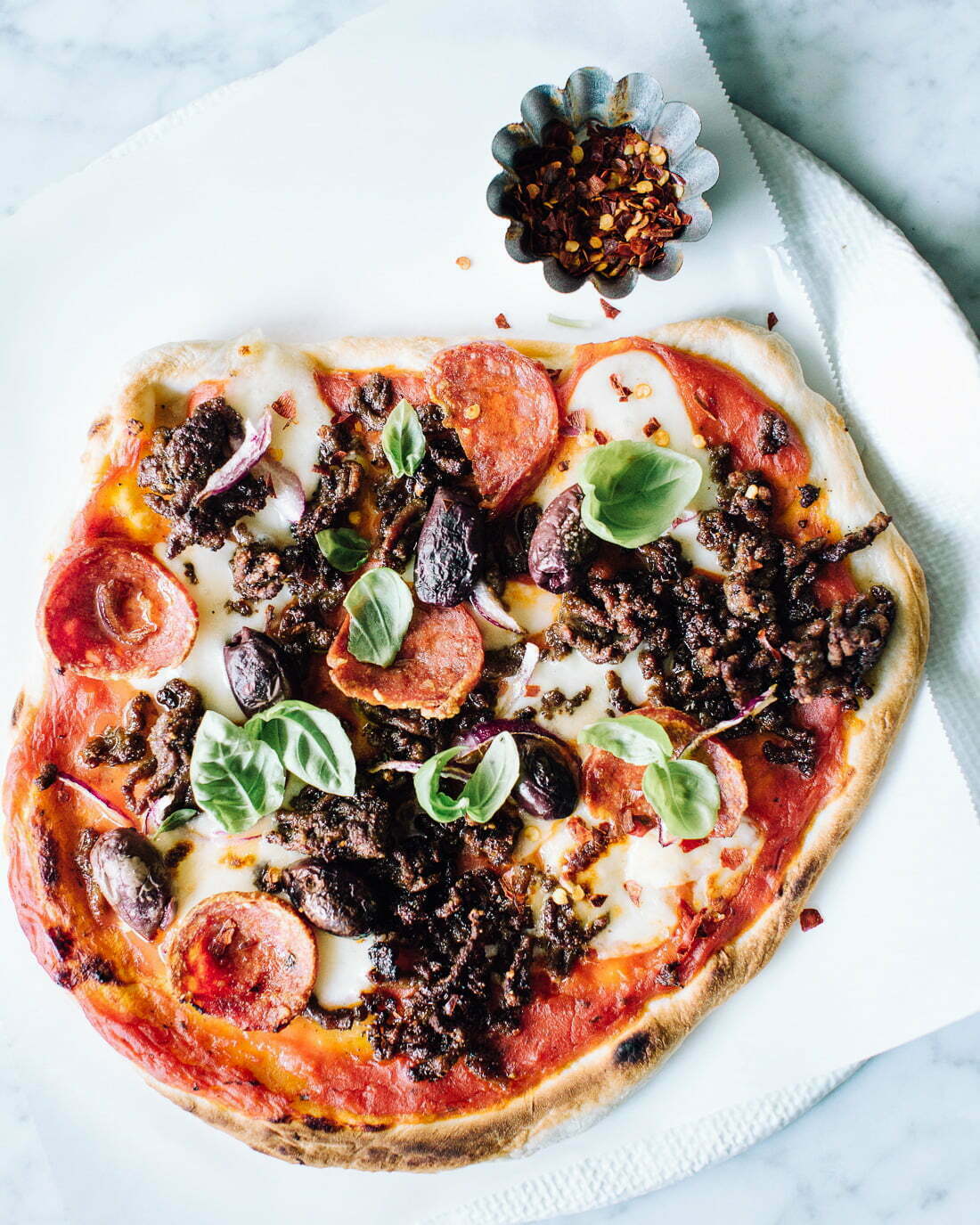
Can you freeze pizza dough?
Pizza dough in general freezes beautifully. And, of course, this quick and easy dough is no exception.
To freeze your pizza dough, let it rise, divide it, and shape into balls as indicated, then transfer balls to a baking sheet to freeze.
Once frozen, pack the balls into freezer bags (this trick keeps them from sticking together in the bag!).
Popular Foodess Pizza Recipes
Here are some yummy pizza ideas if you need topping inspiration –
Pear, Bacon, Crispy Brussels Sprouts & Blue Cheese Pizza
Shrimp Pizza with Garlicky Cream Sauce
Caramelized Onion & Goat Cheese Pizza
How to Serve This Pizza Recipe
Serving pizza is an art in itself. Here’s how to make the most out of your homemade masterpiece:
- Slicing tools: Use a pizza wheel or a large, sharp knife for clean, easy slicing. This will keep your toppings in place and your crust intact.
- Pairing ideas: A simple green salad with a tangy vinaigrette can complement the richness of the pizza. For drinks, consider a crisp beer or a glass of red wine.
- Dipping sauces: Offer a variety of dipping sauces like garlic butter, ranch, or even a spicy marinara for an added layer of flavor.
- Crust optimization: If you love crispy crust, place sliced pieces back in the oven for 1-2 minutes before serving. It crisps up the edges without drying out the toppings.
- Plating: Serve on a wooden pizza peel or large cutting board for a rustic, pizzeria-style presentation.
- Garnishes: A sprinkle of fresh basil, a drizzle of olive oil, or even a dusting of Parmesan can elevate your pizza from homemade to gourmet.
With these serving tips, you’re all set to impress your guests and yourself!
FAQ
Frequently asked questions to help you achieve pizza perfection:
- Is homemade sauce necessary? While a homemade sauce adds a personal touch, a high-quality store-bought sauce can also be a good option.
- Why is my crust soggy? A soggy crust often results from too many wet toppings or insufficient oven temperature. Make sure your oven is hot enough and consider pre-cooking wetter ingredients.
- Can I make a vegan pizza with this recipe? Yes, simply use vegan cheese and your choice of plant-based toppings.
- Do I need a pizza stone? A pizza stone is great for achieving a crispy crust, but a preheated baking sheet or cast-iron skillet can also yield excellent results.
- How long can I store leftover pizza? Leftover pizza can be stored in an airtight container in the refrigerator for up to 5 days.

The Ultimate Easy Pizza Dough Recipe
Ingredients
- 1 ¾ cups warm water (about 110ºF)
- 1 package 2 1/4 tsp active dry yeast
- 1 tsp granulated sugar
- ¼ cup olive oil plus more for bowl
- 1 ½ tsp coarse salt
- 19.5 oz (4 1/3 cups lightly spooned into measuring cup and levelled off) bread flour or all-purpose flour
Instructions
- Combine water, yeast and sugar in bowl of stand mixer and let stand 10 minutes to proof. Yeast should be dissolved and frothy. Add oil and salt.
- Attach dough hook to mixer and turn it on low speed. Slowly add about half of the flour, mixing until it forms a sticky dough. Add remainder of dough a bit at a time until it forms a smooth ball. It’ll still be tacky to touch, but won’t stick to the sides of the bowl. Let mixer knead the dough on low speed for five minutes.
- Lightly oil the bowl and the dough (I just splash a glug of oil and roll the dough all around and up the sides of the bowl to grease the whole thing). Cover and let rise for 1 1/2 hours, until doubled in size.
- Meanwhile, prepare all of your toppings.
- When dough has risen, preheat a large cast-iron pan on high heat for five minutes. Turn on your broiler (with convection turned on if you have it). Set out large baking sheets.
- Divide dough into 8 pieces and roll each into a ball. On a lightly floured counter, roll each ball into a circle of desired crust thinness. Transfer first pizza dough round to hot cast iron pan. When bubbles form and bottom is nicely browned, about 60 seconds, lift it out with a spatula and place on a baking sheet. (If your oven doesn’t offer a convection setting on broil, flip the dough over and let it cook for 30 seconds on the other side, too to make sure it’ll be cooked through.) Repeat with remaining crusts.
- Arrange toppings on pizza crusts and broil until toppings are bubbly and edge of crust is charred in spots (about 5 minutes, but watch carefully and don’t walk away).
Notes
Pin Me!
